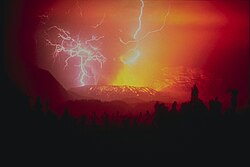
A natural phenomenon is an observable event which is not man-made. Examples include: sunrise, weather, fog, thunder, tornadoes; biological processes, decomposition, germination; physical processes, wave propagation, erosion; tidal flow, and natural disasters such as electromagnetic pulses, volcanic eruptions, hurricanes and earthquakes. [1] [2]















